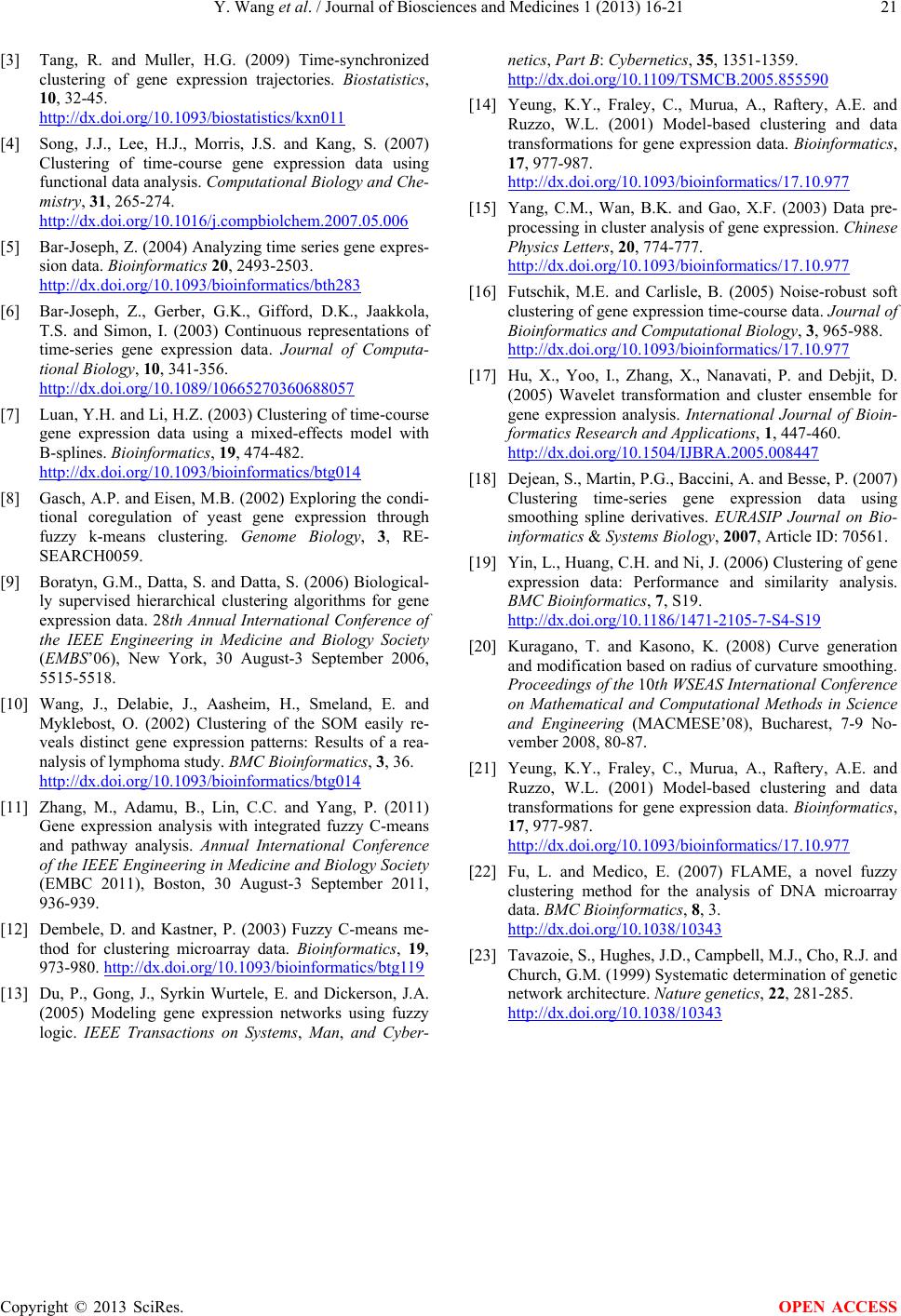
Y. Wang et al. / Journal of Biosciences and Medicines 1 (2013) 16-21
Copyright © 2013 SciRes. OPEN ACCESS
[3] Tang, R. and Muller, H.G. (2009) Time-synchronized
clustering of gene expression trajectories. Biostatistics,
10, 32-45.
http://dx.doi.org/10.1093/biostatistics/kxn011
[4] Song, J.J., Lee, H.J., Morris, J.S. and Kang, S. (2007)
Clustering of time-course gene expression data using
functional data analysis. Computational Biology and Che-
mistry, 31, 265-274.
http://dx.doi.org/10.1016/j.compbiolchem.2007.05.006
[5] Bar-Joseph, Z. (2004) Analyzing time series gene expres-
sion data. Bioinformatics 20, 2493-2503.
http://dx.doi.org/10.1093/bioinformatics/bth283
[6] Bar-Joseph, Z., Gerber, G.K., Gifford, D.K., Jaakkola,
T.S. and Simon, I. (2003) Continuous representations of
time-series gene expression data. Journal of Computa-
tional Biology, 10, 341-356.
http://dx.doi.org/10.1089/10665270360688057
[7] Luan, Y.H. and Li, H.Z. (2003) Clustering of time-course
gene expression data using a mixed-effects model with
B-splines. Bioinformatics, 19, 474-482.
http://dx.doi.org/10.1093/bioinformatics/btg014
[8] Gasch, A.P. and Eisen, M.B. (2002) Exploring the condi-
tional coregulation of yeast gene expression through
fuzzy k-means clustering. Genome Biology, 3, RE-
SEARCH0059.
[9] Boratyn, G.M., Datta, S. and Datta, S. (2006) Biological-
ly supervised hierarchical clustering algorithms for gene
expression data. 28th Annual International Conference of
the IEEE Engineering in Medicine and Biology Society
(EMBS’06), New York, 30 August-3 September 2006,
5515-5518.
[10] Wang, J., Delabie, J., Aasheim, H., Smeland, E. and
Myklebost, O. (2002) Clustering of the SOM easily re-
veals distinct gene expression patterns: Results of a rea-
nalysis of lymphoma study. BMC Bioinformatics, 3, 36.
http://dx.doi.org/10.1093/bioinformatics/btg014
[11] Zhang, M., Adamu, B., Lin, C.C. and Yang, P. (2011)
Gene expression analysis with integrated fuzzy C-means
and pathway analysis. Annual International Conference
of the IEEE Engineering in Medicine and Biology Society
(EMBC 2011), Boston, 30 August-3 September 2011,
936-939.
[12] Dembele, D. and Kastner, P. (2003) Fuzzy C-means me-
thod for clustering microarray data. Bioinformatics, 19,
973-980. http://dx.doi.org/10.1093/bioinformatics/btg119
[13] Du, P., Gong, J., Syrkin Wurtele, E. and Dickerson, J.A.
(2005) Modeling gene expression networks using fuzzy
logic. IEEE Transactions on Systems, Man, and Cyber-
netics, Part B: Cybernetics, 35, 1351-1359.
http://dx.doi.org/10.1109/TSMCB.2005.855590
[14] Yeung, K.Y., Fraley, C., Murua, A., Raftery, A.E. and
Ruzzo, W.L. (2001) Model-based clustering and data
transformations for gene expression data. Bioinformatics,
17, 977-987.
http://dx.doi.org/10.1093/bioinformatics/17.10.977
[15] Yang, C.M., Wan, B.K. and Gao, X.F. (2003) Data pre-
processing in cluster analysis of gene expression. Chinese
Physics Letters, 20, 774-777.
http://dx.doi.org/10.1093/bioinformatics/17.10.977
[16] Futschik, M.E. and Carlisle, B. (2005) Noise-robust soft
clustering of gene expression time-course data. Journal of
Bioinformatics and Computational Biology, 3, 965-988.
http://dx.doi.org/10.1093/bioinformatics/17.10.977
[17] Hu, X., Yoo, I., Zhang, X., Nanavati, P. and Debjit, D.
(2005) Wavelet transformation and cluster ensemble for
gene expression analysis. International Journal of Bioin-
formatics Research and Applications, 1, 447-460.
http://dx.doi.org/10.1504/IJBRA.2005.008447
[18] Dejean, S., Martin, P.G., Baccini, A. and Besse, P. (2007)
Clustering time-series gene expression data using
smoothing spline derivatives. EURASIP Journal on Bio-
informatics & Systems Biology, 2007, Article ID: 70561.
[19] Yin, L., Huang, C.H. and Ni, J. (2006) Clustering of gene
expression data: Performance and similarity analysis.
BMC Bioinformatics, 7, S19.
http://dx.doi.org/10.1186/1471-2105-7-S4-S19
[20] Kuragano, T. and Kasono, K. (2008) Curve generation
and modification based on radius of curvature smoothing.
Proceedings of the 10th WSEAS International Conference
on Mathematical and Computational Methods in Science
and Engineering (MACMESE’08), Bucharest, 7-9 No-
vember 2008, 80-87.
[21] Yeung, K.Y., Fraley, C., Murua, A., Raftery, A.E. and
Ruzzo, W.L. (2001) Model-based clustering and data
transformations for gene expression data. Bioinformatics,
17, 977-987.
http://dx.doi.org/10.1093/bioinformatics/17.10.977
[22] Fu, L. and Medico, E. (2007) FLAME, a novel fuzzy
clustering method for the analysis of DNA microarray
data. BMC Bioinformatics, 8, 3.
http://dx.doi.org/10.1038/10343
[23] Tavazoie, S., Hughes, J.D., Campbell, M.J., Cho, R.J. and
Church, G.M. (1999) Systematic determination of genetic
network architecture. Nature genetics, 22, 281-285.
http://dx.doi.org/10.1038/10343